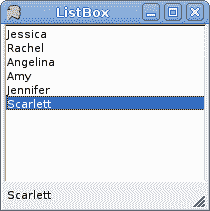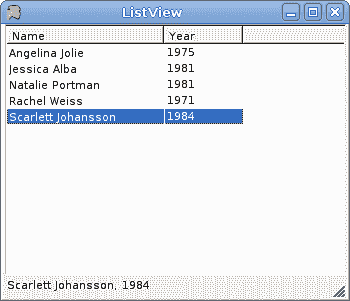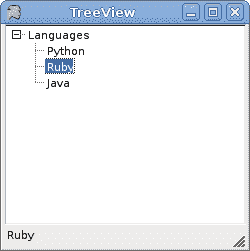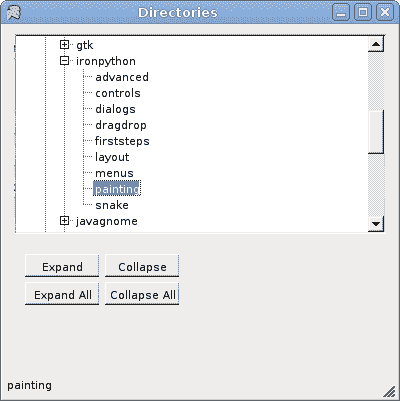Mono Winforms 中的高级控件
在 Mono Winforms 教程的这一部分中,我们介绍一些更高级的控件。 即ListBox,ListView和TreeView控件。
ListBox
ListBox控件用于显示项目列表。 用户可以通过单击选择一个或多个项目。
listbox.cs
using System;
using System.Drawing;
using System.Windows.Forms;
class MForm : Form {
private StatusBar sb;
public MForm() {
Text = "ListBox";
Size = new Size(210, 210);
ListBox lb = new ListBox();
lb.Parent = this;
lb.Items.Add("Jessica");
lb.Items.Add("Rachel");
lb.Items.Add("Angelina");
lb.Items.Add("Amy");
lb.Items.Add("Jennifer");
lb.Items.Add("Scarlett");
lb.Dock = DockStyle.Fill;
lb.SelectedIndexChanged += new EventHandler(OnChanged);
sb = new StatusBar();
sb.Parent = this;
CenterToScreen();
}
void OnChanged(object sender, EventArgs e) {
ListBox lb = (ListBox) sender;
sb.Text = lb.SelectedItem.ToString();
}
}
class MApplication {
public static void Main() {
Application.Run(new MForm());
}
}
我们的示例显示了一个具有六个名称的列表框。 所选项目显示在状态栏中。
ListBox lb = new ListBox();
lb.Parent = this;
ListBox控件已创建。
lb.Items.Add("Jessica");
这就是我们向ListBox控件添加新项目的方式。 该控件具有Items属性。 该属性是对列表框中项目列表的引用。 使用此引用,我们可以添加,删除或获取列表框中的项目数。
lb.SelectedIndexChanged += new EventHandler(OnChanged);
当我们选择一个项目时,会触发SelectedIndexChanged事件。
ListBox lb = (ListBox) sender;
sb.Text = lb.SelectedItem.ToString();
在OnChange()方法内部,我们获得对列表框的引用,并将所选文本设置为状态栏。

图:ListBox
ListView
ListView控件用于显示项目集合。 它是比ListBox控件更复杂的控件。 它可以在各种视图中显示数据,主要用于在多列视图中显示数据。
listview.cs
using System;
using System.Drawing;
using System.Windows.Forms;
using System.Collections.Generic;
public class Actress
{
public string name;
public int year;
public Actress(string name, int year)
{
this.name = name;
this.year = year;
}
}
class MForm : Form {
private StatusBar sb;
public MForm() {
Text = "ListView";
Size = new Size(350, 300);
List<Actress> actresses = new List<Actress>();
actresses.Add(new Actress("Jessica Alba", 1981));
actresses.Add(new Actress("Angelina Jolie", 1975));
actresses.Add(new Actress("Natalie Portman", 1981));
actresses.Add(new Actress("Rachel Weiss", 1971));
actresses.Add(new Actress("Scarlett Johansson", 1984));
ColumnHeader name = new ColumnHeader();
name.Text = "Name";
name.Width = -1;
ColumnHeader year = new ColumnHeader();
year.Text = "Year";
SuspendLayout();
ListView lv = new ListView();
lv.Parent = this;
lv.FullRowSelect = true;
lv.GridLines = true;
lv.AllowColumnReorder = true;
lv.Sorting = SortOrder.Ascending;
lv.Columns.AddRange(new ColumnHeader[] {name, year});
lv.ColumnClick += new ColumnClickEventHandler(ColumnClick);
foreach (Actress act in actresses) {
ListViewItem item = new ListViewItem();
item.Text = act.name;
item.SubItems.Add(act.year.ToString());
lv.Items.Add(item);
}
lv.Dock = DockStyle.Fill;
lv.Click += new EventHandler(OnChanged);
sb = new StatusBar();
sb.Parent = this;
lv.View = View.Details;
ResumeLayout();
CenterToScreen();
}
void OnChanged(object sender, EventArgs e) {
ListView lv = (ListView) sender;
string name = lv.SelectedItems[0].SubItems[0].Text;
string born = lv.SelectedItems[0].SubItems[1].Text;
sb.Text = name + ", " + born;
}
void ColumnClick(object sender, ColumnClickEventArgs e)
{
ListView lv = (ListView) sender;
if (lv.Sorting == SortOrder.Ascending) {
lv.Sorting = SortOrder.Descending;
} else {
lv.Sorting = SortOrder.Ascending;
}
}
}
class MApplication {
public static void Main() {
Application.Run(new MForm());
}
}
在我们的示例中,我们有一个包含两列的列表视图。 在第一列中,我们显示女演员的名字。 在第二个他们的出生日期。 数据存储在List集合中。 通过选择一行,一行中的数据将显示在状态栏中。 另外,通过单击列标题,可以对数据进行排序。
public class Actress
{
...
}
我们使用Actress类存储数据。
List<Actress> actresses = new List<Actress>();
actresses.Add(new Actress("Jessica Alba", 1981));
actresses.Add(new Actress("Angelina Jolie", 1975));
...
我们创建项目并在项目中填充项目。
ColumnHeader name = new ColumnHeader();
name.Text = "Name";
name.Width = -1;
对于列表视图中的每一列,我们创建一个ColumnHeader。 通过将Width设置为-1,列的宽度等于列中最长的项目。
ListView lv = new ListView();
lv.Parent = this;
ListView控件已创建。
lv.FullRowSelect = true;
lv.GridLines = true;
lv.AllowColumnReorder = true;
lv.Sorting = SortOrder.Ascending;
在这里,我们设置控件的四个属性。 该代码行支持全行选择,显示网格线,通过拖动列对列进行重新排序并以升序对数据进行排序。
lv.Columns.AddRange(new ColumnHeader[] {name, year});
在这里,我们将两个ColumnHeader添加到ListView控件中。
foreach (Actress act in actresses) {
ListViewItem item = new ListViewItem();
item.Text = act.name;
item.SubItems.Add(act.year.ToString());
lv.Items.Add(item);
}
此循环填充ListView控件。 每行都作为ListViewItem类添加到列表视图。
lv.View = View.Details;
ListView控件可以具有不同的视图。 不同的视图以不同的方式显示数据。
ListView lv = (ListView) sender;
string name = lv.SelectedItems[0].SubItems[0].Text;
string born = lv.SelectedItems[0].SubItems[1].Text;
sb.Text = name + ", " + born;
在OnChanged()方法内部,我们从选定的行中获取数据并将其显示在状态栏上。
if (lv.Sorting == SortOrder.Ascending) {
lv.Sorting = SortOrder.Descending;
} else {
lv.Sorting = SortOrder.Ascending;
}
在这里,我们切换列的排序顺序。

图:ListView
TreeView
TreeView控件显示项目的分层集合。 此控件中的每个项目都由TreeNode对象表示。
treeview.cs
using System;
using System.Drawing;
using System.Windows.Forms;
class MForm : Form {
StatusBar sb;
public MForm() {
Text = "TreeView";
Size = new Size(250, 250);
TreeView tv = new TreeView();
TreeNode root = new TreeNode();
root.Text = "Languages";
TreeNode child1 = new TreeNode();
child1.Text = "Python";
TreeNode child2 = new TreeNode();
child2.Text = "Ruby";
TreeNode child3 = new TreeNode();
child3.Text = "Java";
root.Nodes.AddRange(new TreeNode[] {child1, child2, child3});
tv.Parent = this;
tv.Nodes.Add(root);
tv.Dock = DockStyle.Fill;
tv.AfterSelect += new TreeViewEventHandler(AfterSelect);
sb = new StatusBar();
sb.Parent = this;
CenterToScreen();
}
void AfterSelect(object sender, TreeViewEventArgs e)
{
sb.Text = e.Node.Text;
}
}
class MApplication {
public static void Main() {
Application.Run(new MForm());
}
}
这是TreeView控件的非常简单的演示。 我们有一个根项目和三个子项。
TreeView tv = new TreeView();
我们创建TreeView控件。
TreeNode root = new TreeNode();
root.Text = "Languages";
...
tv.Nodes.Add(root);
在这里,我们创建一个根节点。
TreeNode child1 = new TreeNode();
child1.Text = "Python";
子节点以类似的方式创建。
root.Nodes.AddRange(new TreeNode[] {child1, child2, child3});
子节点插入到根节点的Nodes属性中。

图:TreeView
目录
下面的代码示例将更深入地研究TreeView控件。
directories.cs
using System;
using System.Drawing;
using System.Windows.Forms;
using System.IO;
public class MForm : Form
{
private TreeView tv;
private Button expand;
private Button expandAll;
private Button collapse;
private Button collapseAll;
private StatusBar sb;
private const string HOME_DIR = "/home/vronskij";
public MForm()
{
Size = new Size(400, 400);
Text = "Directories";
tv = new TreeView();
SuspendLayout();
tv.Parent = this;
tv.Location = new Point(10,10);
tv.Size = new Size(ClientSize.Width - 20, Height - 200);
tv.Anchor = AnchorStyles.Top | AnchorStyles.Left |
AnchorStyles.Right ;
tv.FullRowSelect = false;
tv.ShowLines = true;
tv.ShowPlusMinus = true;
tv.Scrollable = true;
tv.AfterSelect += new TreeViewEventHandler(AfterSelect);
expand = new Button();
expand.Parent = this;
expand.Location = new Point(20, tv.Bottom + 20);
expand.Text = "Expand";
expand.Anchor = AnchorStyles.Left | AnchorStyles.Top;
expand.Click += new EventHandler(OnExpand);
expandAll = new Button();
expandAll.Parent = this;
expandAll.Location = new Point(20, expand.Bottom + 5);
expandAll.Text = "Expand All";
expandAll.Anchor = AnchorStyles.Left | AnchorStyles.Top;
expandAll.Click += new EventHandler(OnExpandAll);
collapse = new Button();
collapse.Parent = this;
collapse.Location = new Point(expandAll.Right + 5, expand.Top );
collapse.Text = "Collapse";
collapse.Anchor = AnchorStyles.Left | AnchorStyles.Top;
collapse.Click += new EventHandler(OnCollapse);
collapseAll = new Button();
collapseAll.Parent = this;
collapseAll.Location = new Point(collapse.Left, collapse.Bottom + 5);
collapseAll.Text = "Collapse All";
collapseAll.Anchor = AnchorStyles.Left | AnchorStyles.Top;
collapseAll.Click += new EventHandler(OnCollapseAll);
sb = new StatusBar();
sb.Parent = this;
ShowDirectories(tv.Nodes, HOME_DIR);
ResumeLayout();
CenterToScreen();
}
void AfterSelect(object sender, TreeViewEventArgs e)
{
sb.Text = e.Node.Text;
}
void ShowDirectories(TreeNodeCollection trvNode, string path)
{
DirectoryInfo dirInfo = new DirectoryInfo(path);
if (dirInfo != null)
{
DirectoryInfo[] subDirs = dirInfo.GetDirectories();
TreeNode tr = new TreeNode(dirInfo.Name);
if (subDirs.Length > 0)
{
foreach (DirectoryInfo dr in subDirs)
{
if (!dr.Name.StartsWith("."))
ShowDirectories(tr.Nodes, dr.FullName);
}
}
trvNode.Add(tr);
}
}
void OnExpand(object sender, EventArgs e)
{
tv.SelectedNode.Expand();
}
void OnExpandAll(object sender, EventArgs e)
{
tv.ExpandAll();
}
void OnCollapse(object sender, EventArgs e)
{
tv.SelectedNode.Collapse();
}
void OnCollapseAll(object sender, EventArgs e)
{
tv.CollapseAll();
}
static void Main()
{
Application.Run(new MForm());
}
}
我们的代码示例在TreeView控件中显示指定主目录的目录。 该应用启动有些延迟,因为它首先读取主目录的目录结构。 表单上还有四个按钮。 这些按钮以编程方式展开和折叠节点。
tv.Scrollable = true;
我们使TreeView控件可滚动,因为该控件显示了大量目录。
ShowDirectories(tv.Nodes, HOME_DIR);
ShowDirectories()方法使用指定主目录中可用的目录填充TreeView控件的节点。
if (subDirs.Length > 0)
{
...
}
我们检查是否有任何子目录。
foreach (DirectoryInfo dr in subDirs)
{
if (!dr.Name.StartsWith("."))
ShowDirectories(tr.Nodes, dr.FullName);
}
我们遍历所有目录。 为此,我们使用了递归算法。 我们还跳过隐藏的目录。 它们以 Unix 系统上的点开头。
trvNode.Add(tr);
此代码行实际上将目录添加到TreeView控件。
void OnExpand(object sender, EventArgs e)
{
tv.SelectedNode.Expand();
}
所有四个按钮都将事件插入到方法中。 这是展开按钮的方法。 它调用当前所选节点的Expand()方法。

图:Directories
在 Mono Winforms 教程的这一部分中,我们介绍了 Winforms 库中可用的几个高级控件。
